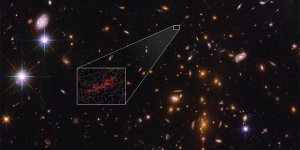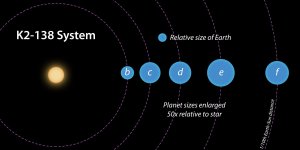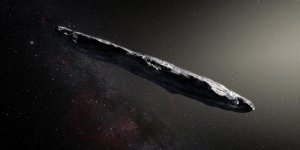Space

An intensive survey deep into the universe by NASA's Hubble and Spitzer space telescopes has yielded the proverbial needle-in-a-haystack: the farthest galaxy yet seen in an image that has been stretched and amplified by a phenomenon called gravitational lensing. »

Researchers using NASA's Mars Reconnaissance Orbiter have found eight sites where thick deposits of ice beneath Mars' surface are exposed in faces of eroding slopes. »

A system of at least five exoplanets has been discovered by citizen scientists through a project called Exoplanet Explorers, part of the online platform Zooniverse, using data from NASA's Kepler space telescope. »

Several research teams will use Webb to explore the mysterious nature of brown dwarfs, looking for insight into both star formation and exoplanet atmospheres, and the hazy territory in-between where the brown dwarf itself exists. »

Many astronomical phenomena can be seen in this giant image, including cosmic dust and gas clouds that reflect, absorb, and re-emit the light of hot young stars within the nebula. »

The MAVEN mission tells us that Mars lost substantial amounts of its atmosphere over time, changing the planet’s habitabilit. We can use Mars as a laboratory for studying rocky planets outside our solar system, which we don’t know much about yet. »

Our solar system now is tied for most number of planets around a single star, with the recent discovery of an eighth planet circling Kepler-90, a Sun-like star 2,545 light years from Earth. »

Data collected by NASA's Juno spacecraft during its first pass over Jupiter's Great Red Spot in July 2017 indicate that this iconic feature penetrates well below the clouds. Other revelations from the mission include that Jupiter has two previously uncharted radiation zones. »

In late December 2014, a submarine volcano in the South Pacific Kingdom of Tonga erupted, sending a violent stream of steam, ash and rock into the air. The ash plumes rose as high as 30,000 feet (9 kilometers) into the sky, diverting flights. »

Observations of two galaxies made with the Atacama Large Millimeter/submillimeter Array (ALMA) radio telescope suggest that large galaxies formed faster than scientists had previously thought. »

A set of thrusters aboard the Voyager 1 spacecraft successfully fired up Wednesday after 37 years without use. »

A cosmic photobomb found as a background object in images of the nearby Andromeda galaxy has revealed what could be the most tightly coupled pair of supermassive black holes ever seen. »

When comet 45P zipped past Earth early in 2017, researchers observing from NASA’s Infrared Telescope Facility, or IRTF, in Hawai’i gave the long-time trekker a thorough astronomical checkup. The results help fill in crucial details about ices in Jupiter-family comets and reveal that quirky 45P doesn’t quite match any comet studied so far. »

For the first time ever astronomers have studied an asteroid that has entered the Solar System from interstellar space. Observations from ESO’s Very Large Telescope in Chile and other observatories around the world show that this unique object was traveling through space for millions of years before its chance encounter with our star system. »

Twice as big as Earth, the super-Earth 55 Cancri e was thought to have lava flows on its surface. The planet is so close to its star, the same side of the planet always faces the star, such that the planet has permanent day and night sides. »

Scientists have long known that solar-energized particles trapped around the planet are sometimes scattered into Earth’s upper atmosphere where they can contribute to beautiful auroral displays. Yet for decades, no one has known exactly what is responsible for hurling these energetic electrons on their way. »

Heat from friction could power hydrothermal activity on Saturn's moon Enceladus for billions of years if the moon has a highly porous core, according to a new modeling study by European and U.S. researchers working on NASA's Cassini mission. »

The ALMA Observatory in Chile has detected dust around the closest star to the Solar System, Proxima Centauri. These new observations reveal the glow coming from cold dust in a region between one to four times as far from Proxima Centauri as the Earth is from the Sun. »

An international team of astronomers discovered an exoplanet, called NGTS-1b, revolving around M-dwarf star NGTS-1, that the team said does not fit existing notions of how stars and planets form. »

NASA's Hubble Space Telescope has found a blistering hot planet outside our solar system where it "snows" sunscreen. The problem is the sunscreen (titanium oxide) precipitation only happens on the planet's permanent nighttime side. »

In partnership with an international team, a group of Brazilian astronomers discovered the existence of a ring around a dwarf planet near Pluto, similar to those of the giant Saturn. The ring revolves around Haumea, located in the so-called Kuiper Belt. »

Powerful solar eruptions could electrically charge areas of the Martian moon Phobos to hundreds of volts, presenting a complex electrical environment that could possibly affect sensitive electronics carried by future robotic explorers, according to a new NASA study. »

Researchers with NASA’s Cassini mission found evidence of a toxic hybrid ice in a wispy cloud high above the south pole of Saturn’s largest moon, Titan. »

For the first time, NASA scientists have detected light tied to a gravitational-wave event, thanks to two merging neutron stars in the galaxy NGC 4993, located about 130 million light-years from Earth in the constellation Hydra. »

The discovery of evidence for ancient sea-floor hydrothermal deposits on Mars identifies an area on the planet that may offer clues about the origin of life on Earth. »

Observations made with the Atacama Large Millimeter/submillimeter Array (ALMA) and ESA’s Rosetta mission, have revealed the presence of the organohalogen Freon-40 in gas around both an infant star and a comet. »

The spectacular planetary nebula NGC 7009, or the Saturn Nebula, emerges from the darkness like a series of oddly-shaped bubbles, lit up in glorious pinks and blues. »

NASA scientists have found evidence that Mars’ crust is not as dense as previously thought, a clue that could help researchers better understand the Red Planet’s interior structure and evolution. »

A thrilling epoch in the exploration of our solar system came to a close today, as NASA's Cassini spacecraft made a fateful plunge into the atmosphere of Saturn, ending its 13-year tour of the ringed planet. »

Hubble Space Telescope has observed a planet outside our solar system that looks as black as fresh asphalt because it eats light rather than reflecting it back into space. »

NASA's Cassini spacecraft is on final approach to Saturn, following confirmation by mission navigators that it is on course to dive into the planet's atmosphere on Friday, Sept. 15. »

Scientists on NASA's Juno mission have observed massive amounts of energy swirling over Jupiter's polar regions that contribute to the giant planet's powerful auroras - only not in ways the researchers expected. »

The sun emitted two significant solar flares on the morning of Sept. 6, 2017. »

Astronomers have found new evidence for the existence of a mid-sized black hole, considered the missing link in the evolution of supermassive black holes. »

Phenomena across the Universe emit radiation spanning the entire electromagnetic spectrum — from high-energy gamma rays, which stream out from the most energetic events in the cosmos, to lower-energy microwaves and radio waves. »